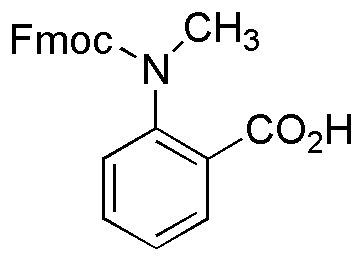Fmoc-N-methyl-2-aminobenzoic acid is widely utilized in research focused on:
- Peptide Synthesis: This compound serves as a protecting group in solid-phase peptide synthesis, allowing for the selective modification of amino acids without interfering with other functional groups.
- Drug Development: It is used in the design of peptide-based drugs, particularly in the pharmaceutical industry, where its ability to enhance stability and bioavailability is crucial.
- Bioconjugation: Researchers employ this chemical in bioconjugation processes, facilitating the attachment of biomolecules to surfaces or other molecules, which is essential in creating targeted therapies.
- Analytical Chemistry: It aids in the development of analytical methods for detecting and quantifying peptides, improving the accuracy and efficiency of biochemical assays.
- Material Science: The compound is also explored in the development of new materials, particularly in creating functionalized surfaces that can interact with biological systems.
General Information
Properties
Safety and Regulations
Applications
Fmoc-N-methyl-2-aminobenzoic acid is widely utilized in research focused on:
- Peptide Synthesis: This compound serves as a protecting group in solid-phase peptide synthesis, allowing for the selective modification of amino acids without interfering with other functional groups.
- Drug Development: It is used in the design of peptide-based drugs, particularly in the pharmaceutical industry, where its ability to enhance stability and bioavailability is crucial.
- Bioconjugation: Researchers employ this chemical in bioconjugation processes, facilitating the attachment of biomolecules to surfaces or other molecules, which is essential in creating targeted therapies.
- Analytical Chemistry: It aids in the development of analytical methods for detecting and quantifying peptides, improving the accuracy and efficiency of biochemical assays.
- Material Science: The compound is also explored in the development of new materials, particularly in creating functionalized surfaces that can interact with biological systems.
Documents
Safety Data Sheets (SDS)
The SDS provides comprehensive safety information on handling, storage, and disposal of the product.
Product Specification (PS)
The PS provides a comprehensive breakdown of the product’s properties, including chemical composition, physical state, purity, and storage requirements. It also details acceptable quality ranges and the product's intended applications.
Certificates of Analysis (COA)
Search for Certificates of Analysis (COA) by entering the products Lot Number. Lot and Batch Numbers can be found on a product’s label following the words ‘Lot’ or ‘Batch’.
Numéro de catalogue
Numéro de lot/série
Certificates Of Origin (COO)
This COO confirms the country where the product was manufactured, and also details the materials and components used in it and whether it is derived from natural, synthetic, or other specific sources. This certificate may be required for customs, trade, and regulatory compliance.
Numéro de catalogue
Numéro de lot/série
Safety Data Sheets (SDS)
The SDS provides comprehensive safety information on handling, storage, and disposal of the product.
DownloadProduct Specification (PS)
The PS provides a comprehensive breakdown of the product’s properties, including chemical composition, physical state, purity, and storage requirements. It also details acceptable quality ranges and the product's intended applications.
DownloadCertificates of Analysis (COA)
Search for Certificates of Analysis (COA) by entering the products Lot Number. Lot and Batch Numbers can be found on a product’s label following the words ‘Lot’ or ‘Batch’.
Numéro de catalogue
Numéro de lot/série
Certificates Of Origin (COO)
This COO confirms the country where the product was manufactured, and also details the materials and components used in it and whether it is derived from natural, synthetic, or other specific sources. This certificate may be required for customs, trade, and regulatory compliance.


